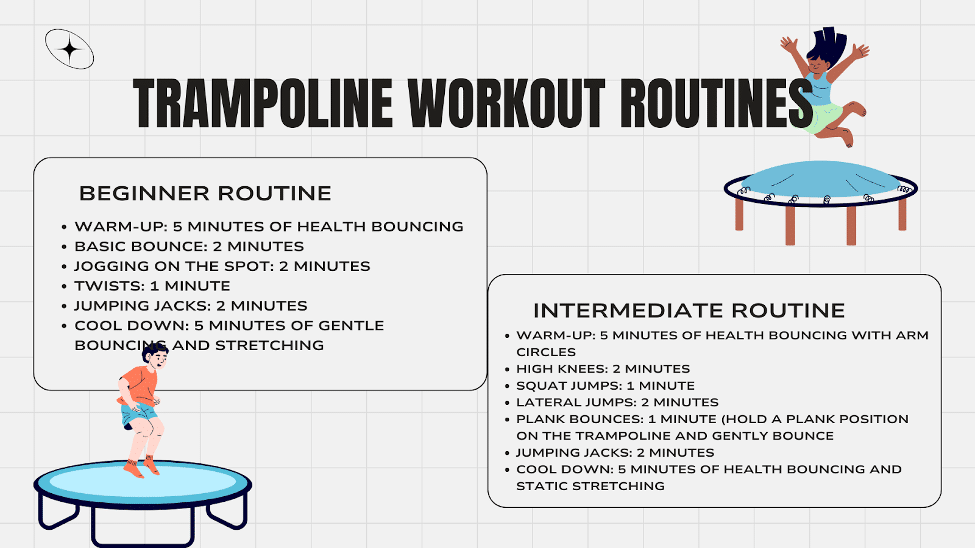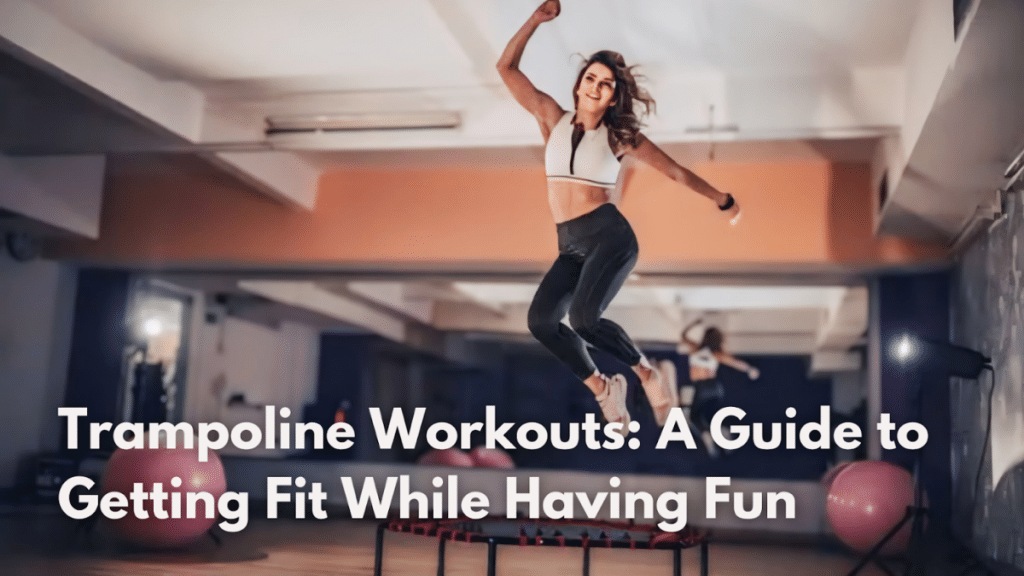Jumping up and down on a trampoline may appear to be child’s play but a trampoline workout can actually be a sophisticated exercise for adults. Trampolines were once just backyard toys for kids. But now, they’ve found a significant place in fitness, blending enjoyment with effectiveness.
If you’re experiencing the effects of aging, such as joint and mobility issues, fret not; the solution may be right in your own home or backyard. And guess what? We have all known this tool all too well, right during our childhood days! This article will provide you with an overview of this emerging wonder in fitness: the trampoline.
The Science Behind Trampoline Workouts
Trampoline exercises adopt the principles of rebounding, low-impact cardiovascular endurance exercise where one jumps on a trampoline. You don’t need a specific trampoline; your own equipment works just fine. The benefits are multifaceted:
Enhanced Cardiovascular Health
Jumping into the air on a trampoline will make your heart pump quickly and the more you do this the better your circulatory health and cardiovascular endurance will become. In a study by the American Council on Exercise (ACE), it has been revealed that the intensity of trampoline workouts is just as great as running, without the wearing out of joints.
Muscle Strengthening and Toning
When combined with the right moves, trampoline exercises can work both the lower (legs) and upper (core and even upper body) body muscles. The instability of the surface keeps adjustments constant that work the muscles in the process, improving muscle tone and strength.
Improved Coordination and Balance
Using your trampolines at home, could address coordination and balance issues with just a few minutes of constant exercise. The act of bouncing and maintaining stability enhances proprioception (body awareness) and coordination. This can be particularly beneficial for older adults as a means to prevent falls.
Joint-Friendly Exercise
The trampoline’s elastic surface absorbs shock on joints, making it ideal for those with arthritis or recovering from injuries.
Mood Enhancement
Through physical activity, endorphins or body feel-betters are released. The simple act of bouncing itself can not only reduce stress and anxiety, but it can also make a trampoline workout a lovely way of keeping a healthy mind.
Types of Trampoline Workouts
There are different ways in which trampoline workouts can be tweaked to favor different levels of fitness and goals Here are some popular types:
Rebounding:
In this, bouncing is involved and usually is in combination with aerobic activities like high knees, jumping jacks and dance steps. It’s a good one to begin with if you are a beginner in trampoline activities.
Strength Training:
Add weights or bands for effective muscle toning and strength development while bouncing. Workouts can consist of bicep curls, shoulder presses, as well as squats.
HIIT (High-Intensity Interval Training):
Put together bouts of high-intensity movement with rest periods. It can include a mixture of some high reps, sprinting in place, and doing some strength moves for the purpose of burning maximum calories and working the cardiovascular fitness out.
Yoga and Pilates on the Trampoline:
Use the trampoline as a prop for yoga and Pilates exercises to add an element of instability, increasing the challenge and effectiveness of core and balance exercises.
Sports Drills:
Athletes use trampolines to improve agility, speed, and power. Drills can include lateral jumps, sprinting, and plyometric exercises.
Getting Started with Trampoline Workouts
Choosing the Right Trampoline: A mini-trampoline, or rebounder, is typically recommended for adults. Ensure it is sturdy, has a good quality mat, and provides adequate support and safety features such as a handrail for beginners.
Warming Up: Just like any other workout, a proper warm-up is essential. Begin with gentle exchanges of light and dynamic stretches to ready your body and avoid any injuries.
Basic Moves to Try:
Basic Moves | Instruction |
Basic Bounce | Keep your feet shoulder-width apart with a slight bending of the knees and then start bouncing lightly.
|
Health Bounce | A gentle bounce where your feet don’t leave the mat, perfect for warming up and cooling down.
|
Jogging on the Spot | Raise your knees as high as if you are running in place. This is beneficial for cardiovascular workout and endurance.
|
Twists | Jump and twist your lower body to the right and left while your upper body is still facing forward. This exercise will not only strengthen your obliques but also enhance your coordination.
|
Jumping Jacks | Perform standard jumping jacks on the trampoline. The added instability increases the challenge and benefits. |
Safety Tips:
- Always make sure the trampoline is level and stable on a flat area.
- See that the area around the trampoline is free of all hazards.
- Wear supportive footwear or go barefoot to enhance friction.
- Keep your core strong to retain balance and save your lower back.
- Pay attention to your body and do not overexert it, especially when you just started.
Trampoline Workout Routines
Here are two sample routines to get you started:

Incorporating Trampoline Workouts into Your Fitness Regimen
Trampoline workouts can be a fantastic addition to your fitness routine. Here are some tips on how to incorporate them:
- Complement Other Workouts: On days when you don’t want to engage in high-impact activities like running or weightlifting, use trampoline workouts as an alternative to relieve joint stress but keep the active lifestyle.
- Mix and Match: Mix trampoline workouts with other activities such as yoga, strength exercises, or cycling to have a comprehensive fitness routine.
- Consistency: Aim for including trampoline exercising 2-3 times per week. Even short periods of 20-30 minutes can yield meaningful advantages.
- Track Your Progress: Use workout journals or fitness apps to trace your progress and stick to your goal. Note improvements in endurance, power, and balance.
The Community and Social Aspect
One of the beautiful things about trampoline workouts is the community aspect. Many gyms and fitness studios now offer group classes on trampolines, creating an exciting and social environment. Group lessons can boost motivation, provide professional guidance, and make the exercises more fun.
Conversely, you can find lots of online platforms and videos that have guided trampoline workouts. This gives you access to an instructor’s guidance from the comfort of your home, thus giving you the much-needed structure and variety in your routine.
Conclusion
Trampoline classes provide a fun, unique, and consistent means of staying physically active. When you mix cardio exercise, muscle strengthening, and balance training into one fun activity, jumping on a trampoline can change your fitness routine. Whether you seek to improve your health, add more types of exercises in your workouts or just to have fun, trampoline workouts are a must-try. Therefore, dance your way to fitness and health, and you will see the effects on your body and mind!
FAQs
Is trampoline exercise safe for all fitness levels?
Yes, trampoline exercise is mostly safe and suitable for everyone’s fitness level as it is low-impact exercise with no stress to the joints. Beginners should start with basic moves and increase the intensity progressively making sure proper form to avoid injuries.
Can trampoline workouts help with weight loss?
Definitely, trampoline exercises help in weight loss by burning calories and improving cardiovascular fitness. Exercise that is done regularly and coupled with a healthy diet can be helpful in weight management.
Do I need special equipment for trampoline workouts?
The main equipment needed is a quality mini-trampoline (rebounder). Accessories including resistance bands and hand weights are also available, but they are not required at the initial stage.

